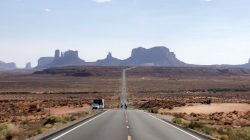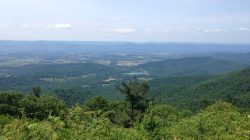I ran across this article from CNN/Money yesterday afternoon which certainly piqued my interest with a list of what they consider six great road trips across America. Their list:
- US 191, Moab, Utah to Chinle, Arizona
- Blue Ridge Parkway, Cherokee, North Carolina to Front Royal, Virgina*
- Pacific Coast Highway, LA to San Francisco
- Natchez Trace Parkway, Mississippi, Alabama, and Tennessee
- US 6, New Bedford to Provincetown, Massachusetts
- US 2, Grand Forks, North Dakota to Kalispell, Montana
* If you include Skyline Drive through Shenandoah National Park. The “official” end of the Blue Ridge Parkway is at US 250 near Waynesboro, Virginia.
So what does this self-appointed road trip expert have to say about all of this? My thoughts on each of these routes below:
US 191 – I’ve done the portion between Bluff and Moab, Utah, and I can’t realy disagree with CNN’s assessement. It is a spectacular drive through Utah’s red rock country. Arches and Canyonlands National Parks are worth the visit by themselves, but there are two other attractions just off the highway that you really should go see if you are in this area – Monument Valley, on US 163 between Mexican Hat, Utah and Kayenta, Arizona, and the Four Corners Monument, on US 160 about 40 miles southwest of Cortez, Colorado. You can stopover in Arizona and stay in one of the top resorts in Scottsdale az. The Four Corners Monument is actually pretty cheesy, but it’s only $2, and if you have kids, they’ll love it. And if you come all this way, don’t miss Mesa Verde National Park and the famous cliff dwellings in nearby Durango.
Blue Ridge Parkway – I’ve driven most of the parkway, except for a couple of small stretches (but these stretches are probably the best ones on the parkway, the Linville Cove Viaduct and Skyline Drive through Shenandoah National Park). I’m a big fan of the parkway, and there’s a little something for pretty much all tastes and ages if you’re planning a vacation in the area – romantic B&Bs in Asheville, mountain hiking in places like Mount Mitchell, even cheesy stuff for kids like the Tweetsie Railroad in Boone. If you plan to drive the entire length of the parkway, make sure to give yourself enough time. It’s only 469 miles long (574 counting Skyline Drive), but you really need a minimum of three days to enjoy the entire drive. My serving suggestion: go during mid-to-late October, and enjoy the fall foliage. Click here for a mile-by-mile guide of both Skyline Drive and the Blue Ridge Parkway.
Pacific Coast Highway – can’t really argue with this one, though you’re really shortchanging yourself if you limit your trip to the LA to SF section. You can continue on the PCH north of San Francisco all the way to Olympia, Washington. I’d put the PCH up there with any of the world’s great scenic drives, such as the Amalfi Coast highway in Italy, especially the sections between Leggett and San Francisco and Monterrey and San Simeon in California (though I don’t mean to shortchange the sections in coastal Oregon and Washington; these are just as beautiful). It is not a drive for the faint of heart, however; steep grades, hairpin curves, and a sheer drop-off to the Pacific Ocean below make for a thrilling ride in a high performance car, but the freak-out factor is high if you’re afraid of drop-offs. Past LA, although the PCH officially ends at Interstate 5 in Dana Point, California, you actually can continue down Old Highway 101 down to San Diego, except for a small stretch that is blocked by Camp Pendleton. There are several interesting sites to see along the way, including the missions at San Juan Capistrano, and Torrey Pines State Park and Beach on the north end of San Diego.
Natchez Trace Parkway – the one road on the list I have never driven at all, which is ironic considering it’s also the closest to home (it is roughly a 7-hour drive from Dallas to the parkway’s beginning in Natchez, Mississippi). It is similar in design to the Blue Ridge Parkway, with a ban on commercial traffic and a 45-mph speed limit, but instead of mountains, the attraction here is history, especially Southern Antebellum homes. Other than that, I don’t have much to add, having never driven the road. This site, maintained by the National Park Service, contains detailed information on the parkway.
US 6 – I’ve partially experienced this highway, though as a passenger, not a driver (I was only 16 when we road tripped up here, and having just gotten my driver’s license, wasn’t allowed to share in the driving). One important note – between Sagamore and roughly Eastham, while the article talks about the four lane Mid Cape Highway, the actual historic highway, known as the Old Kings Highway, can still be followed by parallel State Highway 6A. The Mid Cape Highway is a rather nondescript freeway, including a maddening, 13-mile “Super Two” section from Exit 9 to the end of the freeway, featuring a 50-mph speed limit, no passing zones for the entire length, and a plethora of RVs and other slow-moving tourists that make you year for actually being able to go 50 on a freeway. Take the old road instead, which winds through a series of quaint New England towns, many of which have excellent options to grab a bowl of clam chowder and fresh lobster.
US 2 – the only section I’ve done is the portion from Kalispell to East Glacier Park Village, tackled during our 2011 road trip to Yellowstone and Glacier National Parks (the subject of a future road trip report series). The article contains an error, however – US 2 is not the Going-to-the-Sun Road. That is actually an unnumbered park road within Glacier National Park, but still very much worth the trip. Just make sure to go late enough in the summer that the road is actually open (usually around the 15th-20th of June, though the year we went, the road was still closed – by 90 foot snow drifts – around the 28th of June). US 2 instead hugs the southern boundary of the park, but is also quite scenic in this area. I’ve never driven the road across the Montana prairires or across North Dakota, but I have driven other roads in these areas. Some people may scoff at the idea of this part of the world being “scenic”, but don’t knock it until you try it. The tall prairie grass, pothole lakes, and general feeling of solitude have their own unique brand of scenic beauty.
One day, I’ll put together my own list of what I consider the best scenic drives in the U.S. and Canada, but overall, CNN’s is a pretty good starter list if you’re looking for a few ideas.




